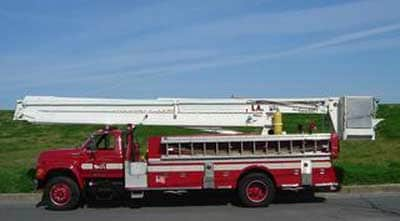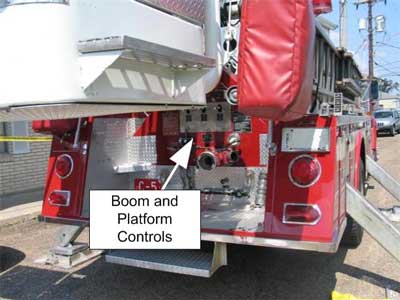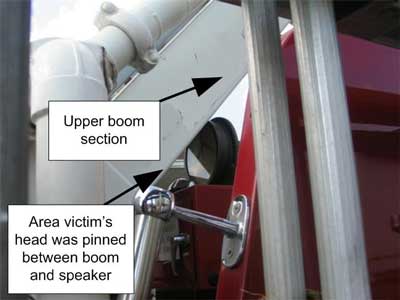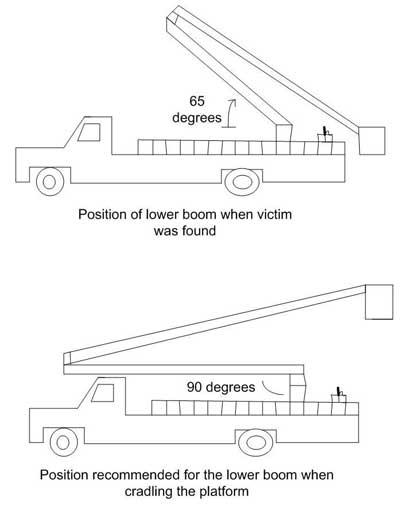Career Fire Fighter Fatally Injured When Struck in the Head by the Boom of an Aerial Platform - Louisiana
 Death in the Line of Duty…A summary of a NIOSH fire fighter fatality investigation
Death in the Line of Duty…A summary of a NIOSH fire fighter fatality investigation
F2008-33 Date Released: June 11, 2009
SUMMARY
On September 29, 2008, a 48-year-old male career fire fighter was fatally injured while operating an articulating aerial platform fire apparatus. The 30-year fire fighting veteran was operating the fire department’s bucket truck to provide an aerial view for an insurance claim adjustor who was assessing hurricane damage to the fire station. After returning to the ground, the victim got on the fire apparatus’ tailboard to access the operating controls to lower and cradle the bucket. Upon lowering the boom, he was struck from behind and his head was pinned between the boom and the apparatus body. A fellow fire fighter came out of the station to check on the victim and found him pinned. The fire fighter moved the boom enough to release the victim. After failed attempts to revive the victim, he was pronounced dead at the scene.
Key contributing factors identified in this investigation included the location of the operating controls on the fire apparatus, possible failure to follow established procedures for safely lowering and cradling the boom, and potentially the age of the articulating boom which was more than 25 years old. Note: The articulating aerial platform fire apparatus was impounded by the city and was not available to the NIOSH investigator. NIOSH was not able to determine if a failure due to the age of the mechanical/hydraulic components had occurred.
NIOSH investigators concluded that, to minimize the risk of similar occurrences, fire departments should
- ensure that standard operating procedures for older equipment include multiple safety measures
- consider retiring automotive fire apparatus more than 25 years old
INTRODUCTION
On September 29, 2008, a 48-year-old male career fire fighter was fatally injured while operating an articulating aerial platform fire apparatus. On September 30, 2008, the victim’s fire department and the U.S. Fire Administration (USFA) notified the National Institute for Occupational Safety and Health (NIOSH) of the fatality. On October 8 – 10, 2008, a General Engineer from the NIOSH Fire Fighter Fatality Investigation and Prevention Program investigated the incident. A meeting was conducted with the department’s Chief and an International Association of Fire Fighters representative. The NIOSH investigator conducted interviews with officers and fire fighters who were at the incident scene. The NIOSH investigator reviewed the department’s standard operating guidelines (SOGs), the victim’s training records, photographs of the incident scene, written witness statements, the coroner’s report, and met with the city police investigator. The articulating aerial platform fire apparatus was impounded by the city and was not available to the NIOSH investigator.
FIRE DEPARTMENT
The combination department has four stations with 19 career and 30 active volunteer fire fighters serving a population of more than 17,400 residents in a geographic area of approximately 4 square miles. The fire department has numerous apparatus, including 4 pumpers (2001,2002, 2004 and 2008), a 2008 quint, a 1968 rescue pumper, 2 aerial trucks (2001 and 1996 (with the refurbished 1965 aerial device involved in the incident), a 2007 utility truck, a 2000 hose tender specialty unit, a 2007 rescue boat, and 2 command vehicles (1980 and 1999). Note: the 1968 rescue pumper, 1980 command vehicle, and the 1965 refurbished aerial platform should be considered for retirement.
APPARATUS
The aerial device (including: the housing, boom, aerial platform and controls for the boom/platform) involved in the incident was originally built in 1965; it included a sixty-five foot, two-section articulating boom with an aerial platform. In 1996, the aerial device with the articulating boom was refurbished and placed on a new cab and chassis from a different manufacturer (see Photo 1). The aerial platform and boom could be operated from the platform control station or the operator’s position at the tailboard. The tailboard controls were located in the center of the tailboard, directly underneath the nested boom (see Photo 2). On top of the control panel was an aerial intercom speaker, approximately 3” high by 12” long. Directly behind and above the speaker was an incline gauge, approximately 12” in diameter (see Photo 3). In the cradled position the bottom of the upper boom is estimated to be approximately 84” from the tailboard. The apparatus was inspected annually by Consolidated Fleet Services, a National Fire Protection Association recognized inspection and certification company. The last date of certificate of inspection was April 5, 2008. The manufacturer’s recommendations for safe operation were included in the fire department’s SOP and were validated by the manufacturer after the incident. Note: To compensate for design and lack of safety features on older equipment, the enhancement of SOPs may be necessary. For example, the presence of a spotter may be required to watch for deviations in procedures and clearance issues when raising/lowering the boom and platform.
 |
 |
|
Photo 2. Tailboard controls underneath |
TRAINING/EXPERIENCE
The fire fighter (victim) had 30 years career fire fighting experience with this department and had completed Fire Fighter 1 and 2 (equivalent to NFPA 1 and 2), HazMat Operations, and various fire prevention courses. The victim had operated the articulating aerial platform fire apparatus over the past 30 years and had trained numerous fire fighters on its operation for the past 20 years. The victim was a pump operator, training instructor and a fire prevention supervisor for the town fireboard.
WEATHER
The weather was overcast and approximately 78 degrees. The winds were calm.
INVESTIGATION
On September 29, 2008, a 48-year-old male career fire fighter was fatally injured while operating an articulating aerial platform fire apparatus. The 30-year fire fighting veteran was operating the fire department’s aerial platform to provide an aerial view for an insurance adjustor to assess damages to the fire station following a hurricane. After returning to the ground, the victim and insurance adjustor stepped out of the platform. The insurance adjustor went to the front of the apparatus to take more pictures of the fire station and was unaware of what the victim was doing. Some time after 1300 hours, the victim got on the tailboard of the fire apparatus to operate the controls to cradle the platform. Upon lowering the boom, he was struck from behind and his head was pinned between the upper boom section and the fire apparatus’ aerial intercom speaker, located on top the control console (see Photo 3). At approximately 1345 hours, a fellow fire fighter came out of the station to check on the victim and found him pinned. The fire fighter yelled to the captain who was inside the fire station to call 911-medical response. The fire fighter moved the boom and released the victim. After failed attempts to revive the victim, he was pronounced dead at the scene.
 |
|
Photo 3. Shows the upper section of the articulating boom in contact with the incline gage and the small area where the victim’s head was pinned. |
The incident was not witnessed. Since NIOSH was not provided access to the apparatus and the apparatus was not tested, it was not possible to determine if a mechanical failure occurred with the apparatus.
The NIOSH investigator hypothesized two different scenarios. One hypothesis is that the lower section of the boom was at approximately 65 degrees (angle of lower section of boom when victim was found), instead of the 90 degrees recommended in the standard operating guidelines, when the upper section of the boom was lowered to meet the lower section (see Diagram). This would have potentially allowed the upper part of the boom to contact the victim’s head, pinning him against the protruding speaker. The victim was 73” tall when wearing station boots. With the upper section of the boom being lowered to meet the incorrectly positioned (65 degrees instead of 90 degrees) lower boom section, this allowed the last few feet of the upper boom section to be at a significant angle causing it to dip below 73” off the tailboard thus contacting the victim. Another hypothesis is that the articulating aerial platform, like any other mechanical device, may have had a mechanical/hydraulic failure causing the boom to descend quicker than the victim expected.
CONTRIBUTING FACTORS
Occupational injuries and fatalities are often the result of one or more contributing factors or key events in a larger sequence of events that ultimately result in the injury or fatality. NIOSH investigators identified the following items as key contributing factors in this incident that ultimately led to the death of the fire fighter:
- The location of the operating controls of the platform and boom and incline gauge being located under the cradled boom position on the apparatus
- Possible failure to follow established procedures for safely lowering and cradling the boom
- And potentially the age of mechanical/hydraulic components of the articulating boom which were more than 25 years old
 |
|
Diagram. Illustrates the angle of the lower boom when victim was found versus the correct position |
CAUSE OF DEATH
According to the coroner’s report, the cause of death was accidental blunt force trauma to the head.
RECOMMENDATIONS
Recommendation #1: Fire departments should ensure that standard operating procedures for older equipment include multiple safety measures.
Discussion: Fire departments may have to develop policies or standard operating procedures to compensate for the deficiencies on older equipment. Standard operating procedures must be constantly reviewed and updated to remain effective. During the review process for equipment SOPs, the fire department should evaluate and address any safety measures to compensate for older equipment lacking modern safety features. These safety measures may require engineering modifications or controls (e.g. kill switches or hard stops) and/or the addition of personnel into the process, such as, a spotter.
In this incident, the victim had over 30 years experience in operating the articulating aerial fire apparatus and had become an instructor/trainer for other fire fighters on the apparatus’s operation. Perhaps, requiring a spotter to assure strict adherence to procedures and watch for clearance issues with the boom and platform may alleviate some safety concerns.
Recommendation #2: Fire departments should consider retiring automotive fire apparatus more than 25 years old.
Discussion: To maximize fire fighter safety, it is important that fire apparatus be equipped with the latest safety features and operating capabilities. Significant improvements in safety features and capabilities of aerial fire apparatus have been made over the past 15 years. Fire departments should consider the value and risk to fire fighters in keeping apparatus over 25 years old. Apparatus manufactured prior to 1991 usually only included a few of the safety upgrades required by recent editions of the National Fire Protection Association (NFPA) fire department apparatus standards.1-4
In this incident, the fire apparatus’ aerial device (which includes the housing, boom, aerial platform and controls for the boom/platform) was more than 43 years old. Although it had been refurbished in 1996 and annual safety inspections for water towers had been performed, in accordance with NFPA 1911, every year since 1992, the apparatus lacked modern design and safety features. The boom and platform controls were located directly under the boom when cradled, introducing the hazard of the operator being struck by the boom or platform. Because the apparatus was not available to NIOSH and was not tested, it could not be determined if there may have been a malfunction of hydraulic components of the aerial device.
Fire apparatus, like any other mechanical device, have a finite life. The life of the fire apparatus depends on many factors, e.g., vehicle use, quality of materials and workmanship by manufacturer, quality of maintenance, and replacement part availability.2
Fire departments that refurbish fire apparatus and place older components on a newer chassis and cab (such as in this incident) may still be lacking significant design and safety feature upgrades. Modern aerial platform fire apparatus designs locate the primary boom controls on the left or right side of the apparatus or on the turntable (the base of the boom or ladder which rotates with the boom or ladder). In addition, most modern apparatus have limit controls to prevent the aerial device from coming in contact with other parts of the cab and body.
Fire departments should consider upgrading older fire apparatus in accordance with NFPA 1912, Standard for Fire Apparatus Refurbishing (latest edition),3 and retire or replace older apparatus in accordance with current standards such as NFPA 1911, Standard For The Inspection, Maintenance, Testing, And Retirement Of In-Service Automotive Fire Apparatus (latest edition).4
Some departments may not have the resources or programs to replace or upgrade their apparatus and equipment as often as they should. Alternative funding sources, such as federal grants to purchase fire apparatus and equipment are available. The primary goal of the Assistance to Fire Fighters Grants (AFG) is to provide critically needed resources to help support equipment purchases such as emergency vehicles and apparatus, equipment, protective gear, training for responders and other needs to help fire departments protect the public and emergency workers from fire and related hazards. The Grant Programs Directorate of the Federal Emergency Management Agency administers the grants in cooperation with the United States Fire Administration.5
Additionally, there are government and non-governmental organizations that can assist fire departments in researching, requesting and writing grant applications. Useful resources include:
- Federal Emergency Management Agency (FEMA), Assistance to Firefighters Grant Program 1-866-274-0960 or firegrants@dhs.gov. For more informationexternal icon from their web site go to http://www.firegrantsupport.com
- Federal Emergency Management Agency (FEMA), Fire Prevention and Safety Grants (FP&S) http://www.firegrantsupport.com/fps/ (Link no longer available 5/13/2015)
- Federal Emergency Management Agency (FEMA), Staffing for Adequate fire and Emergency Response Grants (SAFER)external icon http://www.firegrantsupport.com/safer/ (Link no longer available 5/13/2015) and http://www.nfpa.org/codes-and-standards/standards-development-process/safer-act-grantexternal icon (Link updated 8/13/2013)
- National Volunteer Fire Councilexternal icon http://www.nvfc.org/hot-topics/grants-funding (Link updated 4/9/2013)
- Firegrantshelp.comexternal icon http://www.firegrantshelp.com
REFERENCES
- NFPA [2007]. NFPA 1451 Standard for a fire service vehicle operations training program. Quincy, MA: National Fire Protection Association.
- NFPA [2009]. NFPA 1901 Standard for automotive fire apparatus. Quincy, MA: National Fire Protection Association
- NFPA [2006]. NFPA 1912 Standard for fire apparatus refurbishing. Quincy, MA: National Fire Protection Association
- NFPA [2007].NFPA1911 Standard for the inspection, maintenance, testing, and retirement of in-service automotive fire apparatus 2007 edition. Annex D guidelines for first-line and reserve fire apparatus. Quincy, MA: National Fire Protection Association.
- Federal Emergency Management Agency, Grant Programs Directoratepdf iconexternal icon, http://www.fema.gov/pdf/media/factsheets/2011/gpd_overview.pdf ; April 10, 2009 (Link Updated 5/28/2013)
INVESTIGATOR INFORMATION
This incident was investigated by Matt Bowyer, General Engineer, with the Fire Fighter Fatality Investigation and Prevention Program, Division of Safety Research at NIOSH. An expert technical review was conducted by Battalion Chief and Apparatus Supervisor William C. Peters, Jersey City, New Jersey Fire Department.
|
The National Institute for Occupational Safety and Health (NIOSH), an institute within the Centers for Disease Control and Prevention (CDC), is the federal agency responsible for conducting research and making recommendations for the prevention of work-related injury and illness. In fiscal year 1998, the Congress appropriated funds to NIOSH to conduct a fire fighter initiative. NIOSH initiated the Fire Fighter Fatality Investigation and Prevention Program to examine deaths of fire fighters in the line of duty so that fire departments, fire fighters, fire service organizations, safety experts and researchers could learn from these incidents. The primary goal of these investigations is for NIOSH to make recommendations to prevent similar occurrences. These NIOSH investigations are intended to reduce or prevent future fire fighter deaths and are completely separate from the rulemaking, enforcement and inspection activities of any other federal or state agency. Under its program, NIOSH investigators interview persons with knowledge of the incident and review available records to develop a description of the conditions and circumstances leading to the deaths in order to provide a context for the agency’s recommendations. The NIOSH summary of these conditions and circumstances in its reports is not intended as a legal statement of facts. This summary, as well as the conclusions and recommendations made by NIOSH, should not be used for the purpose of litigation or the adjudication of any claim. For further information, visit the program website at www.cdc.gov/niosh/fire or call toll free 1-800-CDC-INFO (1-800-232-4636).
|
This page was last updated on 06/08/09.
